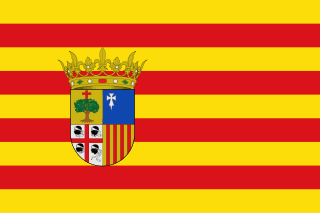
Cantonese cuisine or more accurately, Guangdong cuisine, also known as Yue cuisine (粵菜), refers to the cuisine of China's Guangdong Province, particularly the provincial capital, Guangzhou (Canton). "Cantonese" specifically refers to only Guangzhou or the language known as Cantonese associated with it, but people generally refer to "Cantonese cuisine" to all the cooking styles of the speakers of Yue Chinese languages from within Guangdong. The Teochew cuisine and Hakka cuisine of Guangdong are considered their own styles, as is neighboring Guangxi's cuisine despite also being considered culturally Cantonese. It is one of the Eight Culinary Traditions of Chinese cuisine. Its prominence outside China is due to the large number of Cantonese emigrants. Chefs trained in Cantonese cuisine are highly sought after throughout China. Formerly, most Chinese restaurants in the West served largely Cantonese dishes.

Spanish cuisine is heavily influenced by historical processes that shaped local culture and society in some of Europe's Iberian Peninsula territories. Geography and climate had great influence on cooking methods and available ingredients. These cooking methods and ingredients are still present in the gastronomy of the various regions that make up Spain. Spanish cuisine derives from a complex history where invasions and conquests of Spain have modified traditions which made new ingredients available. Thus, the current and old cuisine of Spain incorporates old and new traditions.

Vietnamese cuisine encompasses the foods and beverages of Vietnam, and features a combination of five fundamental tastes in the overall meal. Each Vietnamese dish has a distinctive flavor which reflects one or more of these elements. Common ingredients include fish sauce, shrimp paste, soy sauce, bean sauce, rice, fresh herbs, fruit and vegetables. Vietnamese recipes use lemongrass, ginger, mint, Vietnamese mint, long coriander, Saigon cinnamon, bird's eye chili, lime, and Thai basil leaves. Traditional Vietnamese cooking is greatly admired for its fresh ingredients, minimal use of dairy and oil, complementary textures, and reliance on herbs and vegetables. With the balance between fresh herbs and meats and a selective use of spices to reach a fine taste, Vietnamese food is considered one of the healthiest cuisines worldwide.

Marination is the process of soaking foods in a seasoned, often acidic, liquid before cooking. The origin of the word alludes to the use of brine in the pickling process, which led to the technique of adding flavor by immersion in liquid. The liquid in question, the 'marinade', can be either acidic or enzymatic. In addition to these ingredients, a marinade often contains oils, herbs, and spices to further flavor the food items.

Ceviche, also cebiche, seviche or sebiche, is a seafood dish typically made from fresh raw fish cured in citrus juices, such as lemon or lime, and spiced with ají, chili peppers or other seasonings including chopped onions, salt, and cilantro. Because the dish is not cooked with heat, it must be prepared and consumed fresh to minimize the risk of food poisoning. Ceviche is usually accompanied by side dishes that complement its flavors, such as sweet potato, lettuce, corn, avocado or plantain. The dish is popular in the Pacific coastal regions of Latin America. Though the origin of ceviche is hotly debated, in Peru it is considered a national dish.

Galbi (갈비), galbi-gui (갈비구이), or grilled ribs is a type of gui in Korean cuisine. "Galbi" is the Korean word for "rib", and the dish is usually made with beef short ribs. When pork spareribs or another meat is used instead, the dish is named accordingly. Galbi is served raw, then cooked on tabletop grills usually by the diners themselves. The dish may be marinated in a sweet and savory sauce usually containing soy sauce, garlic, and sugar. Both non-marinated and marinated galbi are often featured in Korean barbecue.
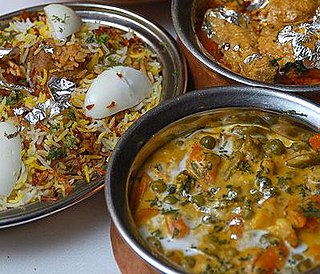
Biryani, also known as biriyani, biriani, birani or briyani, is a mixed rice dish that originates from the Indian subcontinent though the exact origin of the dish is uncertain. This dish is especially popular throughout the Indian subcontinent, as well as among the diaspora from the region. It is also prepared in other regions such as Iraqi Kurdistan. It is made with Indian spices, rice, meat, vegetables or eggs.

Pasanda is a popular meat dish from the Indian subcontinent, notably North Indian, Hyderabadi and Pakistani, derived from a meal served in the court of the Mughal emperors. The word is a variation on the Urdu word "pasande" meaning "favourite", which refers to the prime cut of meat traditionally used within.

Char siu is a popular way to flavor and prepare barbecued pork in Cantonese cuisine. It is classified as a type of siu mei (燒味), Cantonese roasted meat.
Canarian cuisine refers to the typical dishes and ingredients in the cuisine of the Canary Islands, and it constitutes an important element in the culture of its inhabitants. Its main features are its freshness, variety, simplicity, and the richness of its ingredients, the mix of seafood and meat dishes, its cultural influences and the low knowledge of it by the rest of the world. Canarian cuisine is influenced by other cultures, specially the aboriginal inhabitants of the islands (Guanches) and Latin American cuisine. Some African influences still prevail as well.

Escabeche is the name for a number of dishes in Mediterranean and Latin American cuisines which can refer to a dish of fish or meat marinated and cooked in an acidic mixture (vinegar) and sometimes colored with pimenton or saffron. In central or South America the recipes differ from country to country, sometimes including the prior frying of the ingredient to later marinate. It is a common conservation technique, requiring a pH of 4 or lower to effectively stop putrefaction of the product.
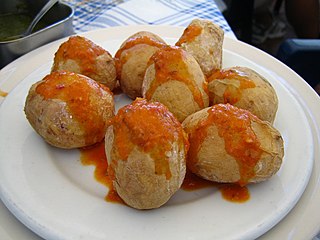
Papas arrugadas is a traditional boiled potato dish eaten in the Canary Islands. It is usually served with a chili pepper garlic sauce, called mojo rojo, or as an accompaniment to meat dishes.

The island of Saint Helena has been influenced by several European powers, by the inhabitants, and the ships passing through, during its history. This has affected the cuisine of Saint Helena, which now has a vibrant and international cuisine variety.
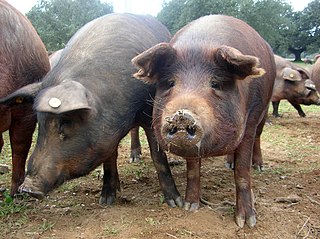
Extremadura, Spain is known for its different ways of preparing the Iberian pork and mutton. The main characteristics of the traditional Extremaduran cuisine were its simplicity, its lack of clutter and its low cost. It is also a cuisine reflecting a generous spirit, for many of its preparations used to be cooked in large pots to share with visitors, friends and neighbors. The resulting dishes are eaten with local bread.
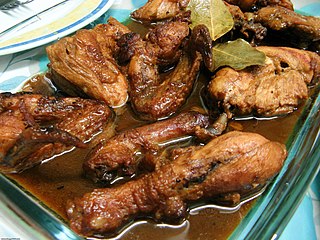
Philippine adobo is a popular Filipino dish and cooking process in Filipino cuisine that involves meat, seafood, or vegetables marinated in vinegar, soy sauce, garlic, and black peppercorns, which is browned in oil, and simmered in the marinade. It has occasionally been considered as the unofficial national dish in the Philippines.

Puchero is a type of stew originally from Spain, prepared in Yucatán, Mexico, Argentina, Paraguay, Uruguay, Perú, south of Brazil, the Philippines, and Spain, specifically the autonomous communities of Andalusia and the Canary Islands. The name comes from the Spanish word "puchero" which means "stewpot".

The cuisine of Oman is influenced by Arab, Persian, Indian, Asian, Eastern Mediterranean, and African cuisine, reflecting Oman's position as a vast trading empire at the intersection of traditional spice trade routes. Dishes are often based on chicken, fish, and lamb, as well as the staple of rice. Most Omani dishes tend to contain a rich mixture of spices, herbs, and marinades.

Balinese cuisine is a cuisine tradition of Balinese people from the volcanic island of Bali. Using a variety of spices, blended with the fresh vegetables, meat and fish. Part of Indonesian cuisine, it demonstrates indigenous traditions, as well as influences from other Indonesian regional cuisine, Chinese and Indian. The island's inhabitants are predominantly Hindu and culinary traditions are somewhat distinct with the rest of Indonesia, with festivals and religious celebrations including many special foods prepared as the offerings for the deities, as well as other dishes consumed communally during the celebrations.

Rabbit stew, also referred to as hare stew when hare is used, is a stew prepared using rabbit meat as a main ingredient. Some traditional regional preparations of the dish exist, such as Coniglio all'ischitana on the island of Ischia, German Hasenpfeffer and jugged hare in Great Britain and France. Hare stew dates back to at least the 14th century, and was published in The Forme of Cury during this time as a recipe for stewed hare. Rabbit stew is a traditional dish of the Algonquin people, and is also a part of the cuisine of the Greek islands. Hare stew was commercially manufactured and canned circa the early 1900s in western France and eastern Germany.

